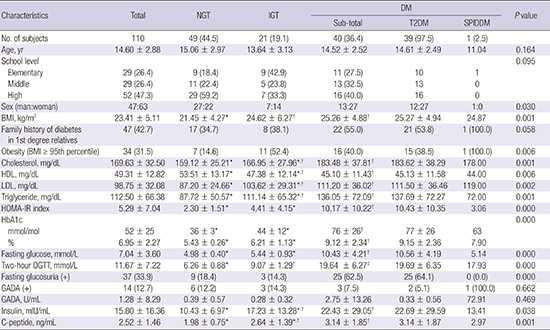1. Daneman D. Type 1 diabetes. Lancet. 2006; 367:847–858.
2. Gungor N, Hannon T, Libman I, Bacha F, Arslanian S. Type 2 diabetes mellitus in youth: the complete picture to date. Pediatr Clin North Am. 2005; 52:1579–1609.
3. Harron KL, Feltbower RG, McKinney PA, Bodansky HJ, Campbell FM, Parslow RC. Rising rates of all types of diabetes in south Asian and non-south Asian children and young people aged 0-29 years in West Yorkshire, U.K., 1991–2006. Diabetes Care. 2011; 34:652–654.
4. Type 2 diabetes in children and adolescents. American Diabetes Association. Pediatrics. 2000; 105:671–680.
5. Copeland KC, Silverstein J, Moore KR, Prazar GE, Raymer T, Shiffman RN, Springer SC, Thaker VV, Anderson M, Spann SJ, et al. Management of newly diagnosed type 2 Diabetes Mellitus (T2DM) in children and adolescents. Pediatrics. 2013; 131:364–382.
6. Committee on Practice and Ambulatory Medicine, Bright Futures Steering Committee. Recommendations for preventive pediatric health care. Pediatrics. 2007; 120:1376.
7. Urakami T, Kubota S, Nitadori Y, Harada K, Owada M, Kitagawa T. Annual incidence and clinical characteristics of type 2 diabetes in children as detected by urine glucose screening in the Tokyo metropolitan area. Diabetes Care. 2005; 28:1876–1881.
8. Urakami T, Owada M, Kitagawa T. Recent trend toward decrease in the incidence of childhood type 2 diabetes in Tokyo. Diabetes Care. 2006; 29:2176–2177.
9. Wei JN, Chuang LM, Lin CC, Chiang CC, Lin RS, Sung FC. Childhood diabetes identified in mass urine screening program in Taiwan, 1993–1999. Diabetes Res Clin Pract. 2003; 59:201–206.
10. Cho BS, Hahn WH, Cheong HI, Lim I, Ko CW, Kim SY, Lee DY, Ha TS, Suh JS. A nationwide study of mass urine screening tests on Korean school children and implications for chronic kidney disease management. Clin Exp Nephrol. 2013; 17:205–210.
11. . . []. Korean School Health Association. The annual incidence of urinary abnormalities in Korean school children(2007–2011) [Internet]. accessed on 15 October 2016. Available at
www.ksha.or.kr.
12. Moon JS, Lee SY, Nam CM, Choi JM, Choe BK, Seo JW, Oh K, Jang MJ, Hwang SS, Yoo MH, et al. 2007 Korean National Growth Charts: review of developmental process and an outlook. Korean J Pediatr. 2008; 51:1–25.
13. Alberti KG, Zimmet PZ. Definition, diagnosis and classification of diabetes mellitus and its complications. Part 1: diagnosis and classification of diabetes mellitus provisional report of a WHO consultation. Diabet Med. 1998; 15:539–553.
14. Matthews DR, Hosker JP, Rudenski AS, Naylor BA, Treacher DF, Turner RC. Homeostasis model assessment: insulin resistance and beta-cell function from fasting plasma glucose and insulin concentrations in man. Diabetologia. 1985; 28:412–419.
15. Lawrence RD. Symptomless glycosurias; differentiation by sugar tolerance tests. Med Clin North Am. 1947; 31:289–297.
16. Urakami T, Morimoto S, Nitadori Y, Harada K, Owada M, Kitagawa T. Urine glucose screening program at schools in Japan to detect children with diabetes and its outcome-incidence and clinical characteristics of childhood type 2 diabetes in Japan. Pediatr Res. 2007; 61:141–145.
17. Urakami T, Miyamoto Y, Fujita H, Kitagawa T. Type 1 (insulin-dependent) diabetes in Japanese children is not a uniform disease. Diabetologia. 1989; 32:312–315.
18. Turner R, Stratton I, Horton V, Manley S, Zimmet P, Mackay IR, Shattock M, Bottazzo GF, Holman R. UKPDS 25: autoantibodies to islet-cell cytoplasm and glutamic acid decarboxylase for prediction of insulin requirement in type 2 diabetes. UK Prospective Diabetes Study Group. Lancet. 1997; 350:1288–1293.
19. Lee SA, Lee WJ, Kim EH, Yu JH, Jung CH, Koh EH, Kim MS, Park JY, Lee KU. Progression to insulin deficiency in Korean patients with Type 2 diabetes mellitus positive for anti-GAD antibody. Diabet Med. 2011; 28:319–324.
20. Kong YH, Kim MS, Lee DY. Comparison of the prevalence of islet autoantibodies according to age and disease duration in patients with type 1 diabetes mellitus. Ann Pediatr Endocrinol Metab. 2013; 18:65–70.
21. Kim MS, Yu KY, Na JI, Kim JD, Lee OK, Lee DY. The changes of incidence of childhood diabetes in Jeollabuk-do for 26 years. J Korean Soc Pediatr Endocrinol. 2008; 13:29–35.
22. Berenson GS, Srinivasan SR, Bao W, Newman WP 3rd, Tracy RE, Wattigney WA. Association between multiple cardiovascular risk factors and atherosclerosis in children and young adults. The Bogalusa Heart Study. N Engl J Med. 1998; 338:1650–1656.
23. Jang M, Berry D. Overweight, obesity, and metabolic syndrome in adults and children in South Korea: a review of the literature. Clin Nurs Res. 2011; 20:276–291.
24. Park MJ, Boston BA, Oh M, Jee SH. Prevalence and trends of metabolic syndrome among Korean adolescents: from the Korean NHANES survey, 1998-2005. J Pediatr. 2009; 155:529–534.
26. West KM, Kalbfleisch JM. Sensitivity and specificity of five screening tests for diabetes in ten countries. Diabetes. 1971; 20:289–296.
27. Friderichsen B, Maunsbach M. Glycosuric tests should not be employed in population screenings for NIDDM. J Public Health Med. 1997; 19:55–60.






 PDF
PDF ePub
ePub Citation
Citation Print
Print




 XML Download
XML Download